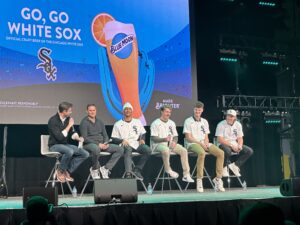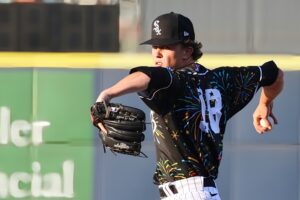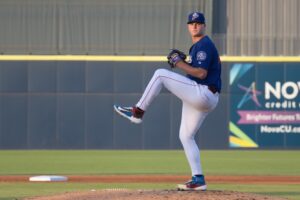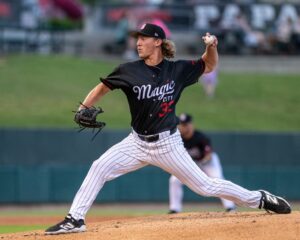Twice annually, FutureSox writers work together to produce a list of the top prospects in the White Sox system. We use a voting system among the staff, then argue out specific players and rankings, until we come to a final list.
This is the full list, including capsules for the top 15, the names for 16-30 and those who just missed the list. For more details on any of the prospects, read our Just Missed teaser and the 16-30 list, each of which have capsules for the players listed.
ELIGIBILITY: We consider a “prospect” any player in the White Sox organization who has not yet achieved MLB Rookie status.
HOW WE EVALUATE PROSPECTS: You can read this primer to get an idea of how we go about the sticky, subjective business of ranking prospects. Our contributors took in a total of 60+ games in person this year at the affiliates as well as Spring Training.
STATE OF THE SYSTEM: There were very few prospects who “graduated” or otherwise left the system, but also not many additions since our last list in July/August of 2018. The White Sox system remains one of the deepest in baseball, listed among the top five in national publications. The bad news is, the injury bug hit the farm hard in 2018 – 12 of that last top 30 missed significant time during the year. The good news is, all but a few should be back by Opening Day, and the rest other than Kopech should be back by May. There is a lot of talent here and plenty to get excited about going into a new season.
FOR MORE DETAILS: If you click on the bolded player’s name, you’ll be taken to that player’s prospect profile, where you can find deeper details, links to videos and other content.
THE LIST
1. Eloy Jimenez, OF [Previous: 1st, no change]
- Signed from the Dominican Republic in 2013 by CHC, acquired via trade in July of 2017
Eloy Jimenez is a top three or four prospect in all of baseball. He’s got literal light tower power that gets grades of 70 or higher on the 20-80 scale. His hit tool is almost as impressive, garnering plus to double-plus marks. Jimenez opened 2018 with AA Birmingham, three years younger than the league average player, and it didn’t matter: .317/.368/.556, 10 HR, 15 2B, 17% K/PA in 53 games. He was promoted to AAA Charlotte where he was 5+ years younger than league average, and he actually hit better: .355/.399/.597, 12 HR, 13 2B, 13% K/PA in 55 games. It’s also true that he is at best an average corner outfielder defensively, but how much does that matter when he can hit like he does? He’s clearly ready for MLB and has been for some time, with some projecting an All Star future. Expect to see him with the White Sox in late April or early May of 2019.
2. Michael Kopech, RHP [Previous: 2nd, no change]
- Drafted 1st Round Supplemental (33rd overall) in 2014 by BOS, acquired via trade December 2016
2018 was a roller coaster for Kopech. He went into the season as one of the top pitching prospects in all of baseball, opening the season at AAA Charlotte some 3-4 years younger than the league average player. Midway through the season he fought a bout with some wildness as he on-boarded a few changes, then it all clicked. His last 7 starts at AAA: 44 IP, 39 H, 9 ER, 4 BB, 59 K. He got the call to the White Sox, flashed some brilliance in three starts, then after his 4th start came out with a torn UCL. Tommy John surgery followed, and he will miss all of 2019. Despite the setback, Kopech remains an elite pitching prospect. A reminder of what he brings: a 70- or 80-grade upper 90’s dancing fastball, a true wipe-out slider that rates plus, 2-seamer and change-up that already rate out around MLB average, and he added back a curveball that looked quite good. He’ll be back in 2020, and there is every reason to believe he’ll be a stud again.
3. Dylan Cease, RHP [Previous: 5th, +2]
- Drafted 6th round in 2014, acquired via trade in July 2017
Dylan Cease had about as good a 2018 as anyone could have hoped for. Fastball command improved, and it’s a beast with a tail that sits 95-99. His plus hammer curve sharpened. His change-up might have made the biggest leap forward and looks to be an above average offering, and the slider and 2-seamer are playable options too. Innings load increased from 93 to 124 with no signs of problems. And the numbers? Across A+ and AA: 2.40 ERA, 6.0 H/9, 3.6 BB/9, 11.6 K/9 and they actually improved at the higher level. In excellent physical and mental shape, Dylan likely opens 2019 with AAA Charlotte and could see the majors before the year is out.
4. Luis Robert, OF [Previous: 3rd, -1]
- Signed from Cuba (indirect) in 2017 for $26M ($50M effective including penalties)
On the flipside, Luis Robert‘s 2018 season did not go as planned. He missed time in two different stints with injuries to the same thumb ligament, and there was a minor hammy in there too. For the regular season he played just 50 games, posting a .269/.333/.360 line across the A-ball teams and a brief rehab stint in rookie ball. That said, he did end the year on a better note, playing 18 games in the AFL and posted a .324/.367/.432 line and showing off his speed and athleticism in the fall showcase. Reminder on the tools here: 70-grade speed, plus raw power, above average hit tool projection, a strong arm and elite athleticism. Entering his age 21/22 season he will probably return to Winston-Salem (at least at first), with everyone hoping he can stay healthy and get enough reps in to refine those substantial tools.
5. Nick Madrigal, 2B/SS [Previous: 4th, -1]
- Drafted 1st Round (4th overall) in 2018
There are some relatively wide gaps in projections for the 4th overall pick in the June draft, both among national analysts and our own. No one doubts the hit tool, on which some have put the exceedingly rare 80 grade – his cartoonish 2.9% K/PA as a pro says hello. Defensively there’s a near-universal thought that he can be very good to elite at second base, and he might be able to play shortstop as well. The team has said they will give him work at both positions. But where some feel he will develop some power as well, others are skeptical. Even with the doubts around his power game, the reasonable floor projection is a major league regular at second base, with the ceiling of an elite defensive middle infielder who might contend for batting titles. Don’t read too much into his overall results in his pro debut, where he went up three levels and was coming back from a nagging injury. Look for Madrigal to move up quickly in 2019, though a major league debut might be more likely in 2020.
6. Dane Dunning, RHP [Previous: 7th, +1]
- Drafted 1st Round Supplemental (29th overall) in 2016 by WAS
Dunning‘s 2018 started so well. He blew away Carolina League hitters in 4 starts (2.59 ERA, 1.1 BB/9, 11.5 K/9) and was quickly promoted to AA Birmingham, where he had 10 more excellent starts (2.78 ERA, 2.9 BB/9, 10.0 K/9). Then he left his 11th start there with an elbow strain and was shut down for the remainder of the season. The team has said he should be ready for Spring Training on a normal regimen. Dunning throws a low 90’s fastball with downhill plane that will touch 95, a mid-80’s slider that has been rated above average, a recently-modified spike curve to which he’s attributed some of his success, and a change-up. Command overall is strong, he’s athletic and a bulldog on the mound. If he’s back to full health, Dunning should return to AA but has a good chance to reach AAA before the season is out.
7. Micker Adolfo, OF [Previous: 9th, +2]
- Signed from Dominican Republic in 2013 ($1.6M)
Like Dunning, Micker Adolfo made big strides last season until injury sidelined him. Micker was diagnosed with a “pinhole” UCL tear prior to the season, but as it didn’t effect his hitting and the club wanted to make sure he got in as much development time as possible, so he DH’d for three months. The results were very encouraging: .282/.369/.464, 11 HR in 79 games. He worked longer counts, went the other way with more regularity, and his strikeout rate went down again by a little bit. Adolfo almost came back to the outfield in July – read his guest post on our site to get that full story. With Tommy John surgery now done, Micker has already begun hitting, and the plan is for him to be throwing again soon and to be back in April or May tentatively. Adolfo has plus or better power, a cannon arm when healthy, plenty of athleticism and speed for the corners and an improving hit tool. Lots of ceiling room here.
8. Zack Collins, C [Previous: 6th, -2]
- Drafted 1st Round (10th overall) in 2016
There really are no in-between tools for Zack Collins. His power is at least plus, not just raw but in games (34 HR over his first two full seasons). His batting eye is elite, resulting in ultra-high walk rates (19% in 2018). But the hit tool is an open question. He’s been hitting in the .220’s to .240’s as a pro, with high strikeout rates (29.7% last year) as he tinkers with his approach and swing. Defensively, most analysts still feel he’s not likely to be able to stick behind the plate (at least not full time) in the long run, but the Sox are rightly going to keep trying that route. His arm will play but the rest of the defensive game is in question, though we’ve talked with people who feel strongly that he’s improved. As tempting as it would be to get that power and OBP combo to Chicago as soon as possible, the best plan for Collins long term is to give him more time in AA and AAA to smooth out his swing and see if he can be a major league starting catcher.
9. Luis Alexander Basabe, OF [Previous: 10th, +1]
- Signed from Venezuela in 2012 ($450k) by BOS, acquired via trade December 2016
Basabe had another good year in 2018 as he continues to fill in the skills that his tools say could be very good. He had no problems with High-A pitching (.266/.370/.502, 9 HR in 58 games) and was promoted to AA Birmingham, where he wasn’t as prolific but still showed plenty well for a 21-year-old in the Southern League (.251/.340/.394, 6 HR in 61 games). Basabe’s tools are tantalizing: plus speed, a strong enough arm to easily cover any outfield slot, above average power potential, and defensive skills that give him a good shot to stick in center. The hit tool is a little more in question, but even there he’s shown a decent eye and there is reason for confidence in further development. He’ll be 22 in 2019 so there is no huge rush, though he is on the 40-man roster so the team will want to challenge him a bit. Look for Basabe to reach AAA in 2019, if not on Opening Day then a little later.
10. Luis Gonzalez, OF [Previous: 13th, +3]
- Drafted 3rd Round in 2017
Gonzalez wasn’t in any conversations for being a top ten prospect in the system when he was drafted, or even a year ago, but he’s starting to get that level of recognition now. He doesn’t have a truly elite tool in the way that Adolfo (power), Robert (speed) or Rutherford (hit) does, but a case can be made that he’s got above average potential in all five categories. Defensively he shows as a true center fielder with excellent instincts, plenty of speed and a strong arm. In terms of the hit tool he not only batted over .300 last year across A-ball, he also walked at an above average rate and made lots of contact with a disciplined approach at the plate. Power-wise he clubbed 14 long balls in 2018 and that’s not just an apparition – watching him in BP and looking closely at his swing, that power is real. It’s worth noting that while the UNM product was selected in the 3rd round, there were analysts who saw him as a 1st round talent. Gonzalez should be at AA to open 2019 at age 23 in order to stay ahead of the age curve.
11. Blake Rutherford, OF [Previous: 11th, no change]
- Drafted 1st round (18th overall) in 2016 by NYY, acquired via trade July 2017
Rutherford needed a bounce-back year in 2018, and he got it. In his age 20/21 season with Winston-Salem the outfielder hit .293/.345/.436 with 7 home runs (he had 5 total in his previous 1.5 pro seasons), stole 15 bags and hit 9 triples for good measure. There are two key questions that Blake needs to answer that will determine his likely future. One is power; the increase in long balls is good, and he does show higher raw in BP giving hope for more translation, but if he’s a corner guy he will need to show more of it in games. Which leads the second question around his defense. He’s got enough arm for any slot and the speed for at least the corners, but can he man center field? It’s hard to say for sure since he’s blocked there by the previously-listed Robert, Basabe and Gonzalez. If he can add more over-the-fence power in games and/or make a strong case to be a center fielder going forward, his value could jump. Right now he’s a tweener.
12. Alec Hansen, RHP [Previous: 8th, -4]
- Drafted 2nd Round in 2016
There are players that are hard to rank, and then there’s Alec Hansen. He was a potential 1-1 draft candidate going into his junior year at OU, then a disastrous junior campaign allowed him to slip to the Sox in the 2nd round, a revelatory 2017 and 2018 run that put him on some Top 100 MLB prospect lists, and then… 2018. A forearm strain caused a delayed start to Alec’s season, the 6’9″ righty went to Birmingham and had lost all semblance of command and control, walking 42 batters in 35.2 IP. Demoted to Winston-Salem to work more closely with his pitching coach whisperer, Matt Zaleski, things improved only marginally. Hansen’s talent when he’s on (like in 2016 and 2017) is huge: a 70-grade fastball in the mid-to-upper 90’s, with a slider, curve and change-up, all of which have shown hints of becoming average or above. Command wasn’t surgical even when he was on, but it was certainly playable. Will it return? It has before, so we’re betting there is a decent chance that happens.
13. Zack Burdi, RHP [Previous: 12th, -1]
- Drafted 1st round (26th overall) in 2016
Tommy John surgery and rehab behind him, Burdi squeezed in 6.1 IP in rookie ball late in the season, then went to the AFL and threw another 4.2 frames. He has missed a year-plus of pitching, so the safe expectation is that he should return to pitch nearly full-time in 2019 but that the results may not be quite ideal right away. Reports of diminished velocity in those AFL looks are a concern, but probably not one to focus on given the context. Before tearing his UCL, Burdi was arguably the best relief pitching prospect in baseball. His 80-grade fastball runs 97 to 102 with movement, and his slider around 90 gets serious two-plane break. He’s also got a change-up in the upper 80’s that is less refined. If he can get back to that repertoire, he could be a very good high-leverage bullpen arm. But it could be late 2019 or even 2020 before he gets to that point.
14. Jake Burger, 3B [Previous: 14th, no change]
- Drafted 1st Round (11th overall) in 2017
More injuries and missed time. Burger tore his achilles tendon in Spring Training, then re-tore it in May, and has been rehabbing it since. The last report we received indicated a return to regular play around May or June of 2019. The lost development time at this stage in his career is a blow, but most victims of this injury among young athletes recover 100% and he’s still only 22. When he was drafted, Burger was seen as one of the most polished bats in the class, with high marks for plate approach and bat-to-ball skills. He’s also got 70-grade power as his carrying tool. Defensively there are questions about him sticking at third base, but some analysts feel he can make it work. May can’t come soon enough for Jake.
15. Steele Walker, OF [Previous: 15th, no change]
- Drafted 2nd Round in 2018
Walker is generally ranked behind the formidable cluster of outfield prospects hovering in the 7-12 range on team lists, but how much of that is based on his pro debut? The Oklahoma draftee came into the Sox system battling back from a frustrating oblique injury, so his numbers in 44 games across three levels should come with a heaping pile of salt. Reading from draft-time reports (see his profile for details and sources), Walker has a quick, compact stroke that favors line drives and allows him to spray hits all over the field. The advanced hit tool is complemented by average projected power and above average speed. Defensively, the Sox have stated they feel he can play center, though not all scouting reports agree. If he can do that, with his other tools and some hints at the potential for more than that average power, then look for him to rise up these lists. It is probably best to throw out his 2018 numbers and wait for a good look in 2019, where he will likely open at Kannapolis.
16. Seby Zavala, C [Previous: 17th, +1]
17. Ian Hamilton, RHP [Previous: 19th, +2]
18. Gavin Sheets, 1B [Previous: 18th, No change]
19. Jordan Stephens, RHP [Previous: 16th, -3]
20. Tyler Johnson, RHP [Previous: 23rd, +3]
21. Bryce Bush, 3B [Previous: Unranked]
22. Jimmy Lambert, RHP [Previous: 26th, +4]
23. Bernardo Flores, LHP [Previous: 28th, +5]
24. Konnor Pilkington, LHP [Previous: 21st, -3]
25. Laz Rivera, SS [Previous: Unranked]
26. Lenyn Sosa, SS [Previous: 23rd, -3]
27. Luis Curbelo, SS/3B [Previous: 27th, No change]
28. Jonathan Stiever, RHP [Previous: Unranked]
29. Kodi Medeiros, LHP [Previous: 22nd, -7]
30. Spencer Adams, RHP [Previous: 20th, -10]
To see a list of players we considered for the Top 30 but just didn’t fit, read our Just Missed article.
Want to know right away when we publish a new article? Type your email address in the box on the right-side bar (or at the bottom, if on a mobile device) and click the “create subscription” button. Our list is completely spam free, and you can opt out at any time.





